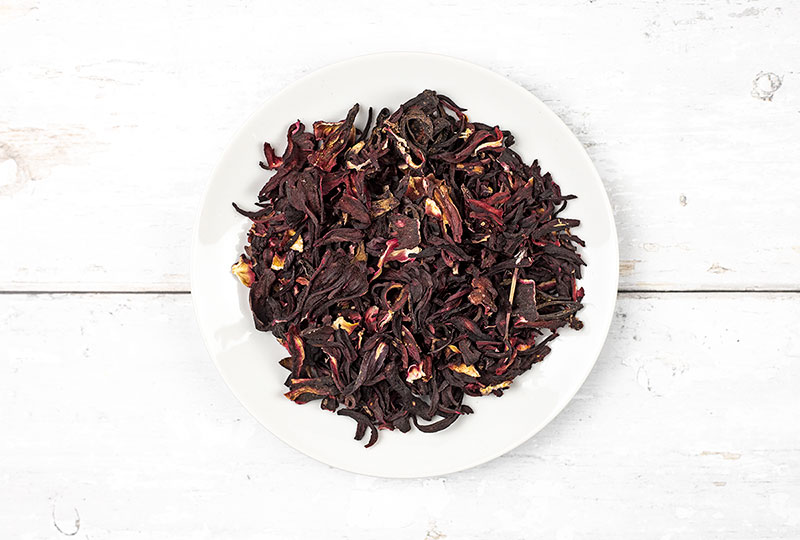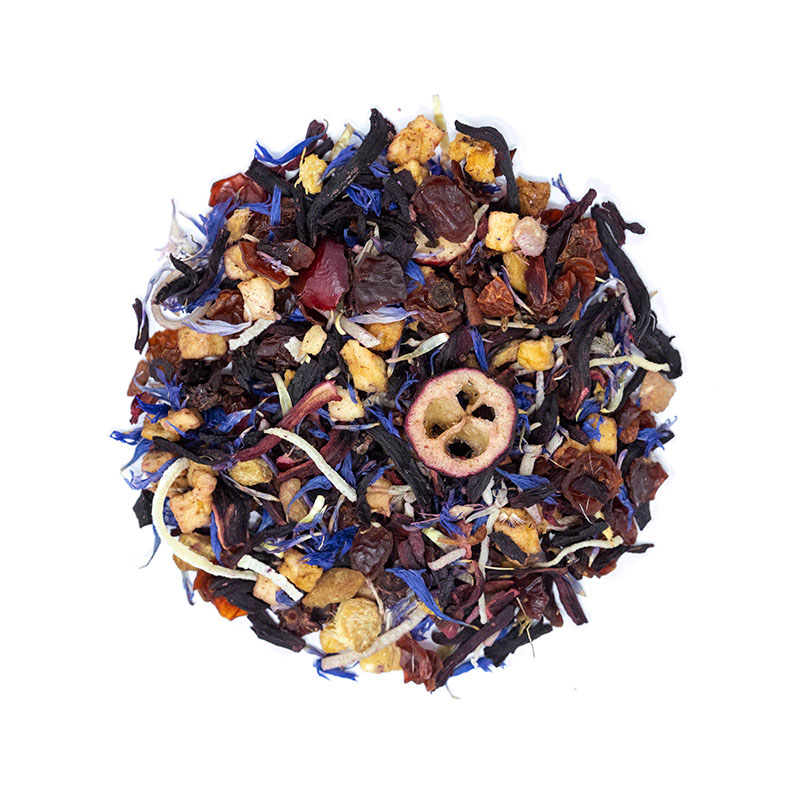Hibiscus Tea Guide
This post may contain affiliate links. Simple Loose Leaf is a participant in the Amazon Associates Program, an affiliate advertising program designed to provide a means for sites to earn advertising fees by linking to Amazon.com.
Dark crimson red, incredibly refreshing and tart, and a joy to brew - hibiscus tea is one of the most popular flower teas in the world. Although it’s called hibiscus flower tea, it’s not made from the actual flower petals. Learn more about hibiscus tea.
What is hibiscus tea?
Hibiscus tea is a herbal infusion made from fresh or dried hibiscus flower petals or sepals. Although there are many types of hibiscus plants, the most commonly used one for making tea is Hibiscus sabdariffa with white flowers and red-colored calyx. Calyx is the outer part of the flower that holds the petals. It can be eaten raw, it’s available sugared, and it’s the most delicious part of the hibiscus plant, packed with benefits – and that’s exactly why it’s used for making tea. Hibiscus tea has a very unique flavor, intensely tart, but slightly sweet. It can add depth and intensity to other drinks, and tastes delicious ice cold. Hibiscus is usually grown in countries with a moderate or hot climate. The hibiscus sabdariffa which is usually used for making tea is native to Africa and Asia. The other name for this hibiscus is roselle- commonly also used when referring to the actual infusion. The other hibiscus plant used for making tea is Hibiscus rosa-sinensis.
Hibiscus Tea Benefits
Hibiscus tea doesn’t only taste delicious, it may provide many health benefits too. It's rich in Vitamin C, minerals, amino acids and carotene.[1] It contains citric and malic acid, anthocyanin[2], purple pigment that’s also a powerful antioxidant found in purple tea. Other polyphenols in hibiscus flower are hibiscitrin, gossypitrin and sabdaritrin[3].What is this tea good for?
Traditionally, hibiscus tea has been used for treating diabetes, high blood pressure, lowering cholesterol and for its diuretic effect. Scientifically backed benefits of hibiscus tea are:1. Antioxidative activity
Drinking hibiscus tea may help boost immune system. Hibiscus is rich in antioxidants and may provide free radical scavenging activity and prevent oxidative stress[4]. Anthocyanins are mainly responsible for antioxidant activity and may help prevent many diseases–from cancer to chronic inflammation[5].2. Antimicrobial and antiviral activity
Studies show that hibiscus calyx may have an antimicrobial properties and help with some bacteria resistant to many antibiotics such as Salmonella and E.coli[6]. It may also provide an antiviral activity, and a therapy for type A influenza[7].3. Anticancer activity
Studies showed that hibiscus may have a potential in cancer treatments as it has something called a “selective toxicity[8]”. It may have the ability to prevent cell mutations and prevent cancers from developing[9]. Another study suggests it may be very beneficial in treating breast cancer, as it may recognize and destroy cancer cells without influencing the normal healthy cells[10]. The anticancer activity has been tested on other types of cancer too, such as liver cancer[11] and prostate cancer[12].4. Aiding Weight loss
Hibiscus tea may be one of the potentially tastiest weight loss aids. Studies suggest this tea could help in reducing body weight and prevent further fat accumulation.[13] Furthermore, drinking two cups a hibiscus tea a day may help with lowering blood pressure[14]. Hibiscus may help lower bad cholesterol, blood sugar[15] and reduce the risk of heart diseases[16].5. Anti inflammatory activity
Studies suggest that some types of hibiscus flowers may provide anti inflammatory effect on acute inflammations[17].Caffeine Content
Hibiscus flowers and calyx are caffeine free. They are likely safe for all age groups. Because of zero caffeine, pure hibiscus tea is great for any time of the day or night and makes for a perfect iced tea to sip throughout the day. Hibiscus tea blend mixes with real teas, such as green or black tea, will always contain caffeine.How to Make Hibiscus Tea: Brewing Tips
Hibiscus tea tastes delicious, consumed hot and cold. To make a cup of hot hibiscus tea you will need dried or fresh hibiscus flowers. Fresh flowers may not be readily available, so they are rarely used for making tea. Dried flowers are easy to use and can come in different “leaf” size. Use about 1-2 teaspoons of dried flowers per cup of water. Bring fresh spring water to a boil and steep the leaves for 5 to 10 minutes. Strain and add honey if needed. If you want to enjoy hibiscus iced tea, once brewed, let the tea cool down and serve over ice.Hibiscus Tea Recipe
Hibiscus tea is popular world-wide and many countries have their own version of a hot or cold hibiscus drink. Some of them are Agua de jamaica in Mexico, Zobo in Nigeria, Karkade in Egypt and Sorrel in the Caribbean. Agua de jamaica is a type of cold hibiscus drink or agua fresca, made with pure dried hibiscus flower and served over ice. However, it can be enriched with cinnamon, ginger or other ingredients. But hibiscus tea can be blended with many other ingredients. Its tart and sweet flavor blends great with even stronger, more aromatic plants. Our favorite hibiscus tea recipe is infused with a spirit, flavors and colors of the Mediterranean. It combines two ingredients that are rarely used together and enriched with a few drops of bergamot orange juice. Don’t have a bergamot orange? Replace it with lime juice. You will need:- 1 rosemary sprig
- 2 teaspoons of dried hibiscus flowers
- ½ teaspoon of bergamot orange juice
- Ice
- 1 cup of boiling water
- Bring fresh spring water to a boil.
- Wash fresh rosemary sprig under cool water.
- Put rosemary and hibiscus into a cup.
- Add hot water and let it steep for 5-10 minutes.
- Strain and squeeze in a few drops of bergamot orange juice.
- Fill the tall glass with ice and pour in the tea.

Plum Spice fruity tea blend
Where to buy?
Hibiscus tea blends are available from many tea shops. Pure dried flowers are usually sold in specialised shops. In some countries, such as Greece or Mexico, they may be available from many street shops too.Disclaimer: This article is for informational purposes only. It’s not intended to replace medical advice, diagnosis or treatment. Every person is different and may react to different herbs and teas differently. Never use teas or herbs to treat serious medical conditions on your own. Always seek professional medical advice before choosing home remedies.




Leave a comment